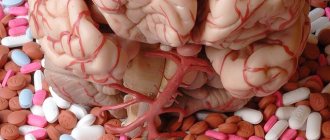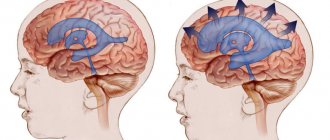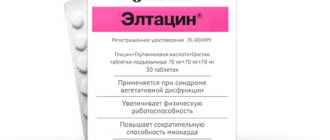Causes of pseudobulbar dysarthria in children
The immediate cause of the defect is damage to the pathways, that is, the nerve fibers connecting the nuclei of the bulbar nerves in the medulla oblongata with the cerebral cortex. The bulbar nerves are the vagus, glossopharyngeal and hypoglossal. The names make it clear which muscles these nerves innervate.
In pathology, the interaction is disrupted. The activity of the nuclei increases, which causes hypertonicity of the articulatory muscles. This makes it difficult for muscles to oscillate when speaking, reduces the ability to make active movements, and interferes with the process of swallowing and chewing food. At the same time, a characteristic of pseudobulbar dysplasia is the preservation of reflex acts that do not require control from the cortex - for example, licking the lips when food enters.
Such violations lead to:
- traumatic brain injuries - concussion, bruise, which are accompanied by damage to the brain matter and the formation of hematomas. They, in turn, cause disruption of blood flow and compression of the pathways. Children can also be injured during childbirth as a result of inadequate management of labor;
- perinatal pathology - intrauterine infections, asphyxia and hypoxia, entanglement of the umbilical cord, birth injuries, complicated pregnancy and childbirth are fraught with damage to the brain substance;
- neuroinfections - encephalitis, syphilitic brain damage, tuberculosis leads to an inflammatory process in the listed structures;
- neurodegenerative diseases - amyotrophic lateral sclerosis, leukodystrophy leads to the gradual death of nerve fibers connecting the cerebral cortex and bulbar nuclei;
- cerebrovascular disorders - strokes (they are rare in children, but they do occur), encephalopathy (perinatal, diabetic), angiopathy.
Description of the disease
Pseudobulbar dysarthria is a speech disorder caused by paralysis affecting the articulatory muscles. They are constantly either in hypotonicity - relaxed, or in hypertonicity - overly tense. This occurs due to a rupture of the pyramidal tract, so the influence of the cerebral cortex on the spinal cord segments is disrupted.
Disruption of the connection between the speech apparatus and the central nervous system leads to a malfunction of the muscles responsible for the reproduction of sounds. Problems with the speech motor analyzer arise when there is bilateral damage to the corticonuclear pathways connecting the nuclei of the bulbar nerve endings.
In simple terms, this is a disease in which a child is physically unable to pronounce individual sounds and even words, or fully express his emotions. This usually manifests itself as follows:
- fast or too slow speech;
- unintelligible pronunciation;
- not saying the endings of words;
- distorted pronunciation of sounds or replacing them with others;
- unnatural inactivity of the muscles of the lower part of the face;
- open mouth
- involuntary flow of saliva.
Pathology develops with general lesions of the central nervous system of varying severity, for example, cerebral palsy. Changes manifest themselves in young children, mainly in disorders of sucking, chewing, swallowing, and respiratory dysfunction. It depends on the form of the disease.
A characteristic differential sign of the development of pseudobulbar dysarthria is precisely bilateral paralytic damage to the muscles of the tongue, palate, and larynx. As a result, there is a restriction of movement, articulation and phonation.
In some cases, with bilateral paresis, the degree of damage to one side of the organ may prevail over the other. Sometimes a whole series of involuntary movements are preserved, while voluntary ones simply disappear.
Degrees and forms of pseudobulbar dysarthria in children
There are 3 degrees of pseudobulbar dysarthria:
- A mild degree is characterized by the absence of gross violations. The movements of the articulatory organs are slowed down. The speech is understandable, but a little blurry and inexpressive. Rare choking is possible;
- With moderate severity, the signs of pseudobulbar dysarthria are more pronounced, and speech is practically incomprehensible to others. There are problems with chewing, swallowing, facial expressions, and drooling;
- A feature of severe pseudobulbar dysarthria is complete anarthria, that is, lack of speech. The mouth is constantly open, the lower jaw “hangs”, salivation is profuse, the tongue is motionless. Chewing and swallowing of food are severely impaired.
According to another classification, speech therapists take into account the spastic form of pseudobulbar dysarthria, paretic and mixed. Spastic is characterized by muscle spasm, paretic - paresis, mixed has signs of two forms.
Varieties and their manifestations
In addition to the fact that there are several types of dysarthria, pseudobulbar dysarthria, in turn, occurs in the following forms:
1. Paretic . It is characterized by hypotonia of speech and general skeletal muscles. An increase in tone can be observed with voluntary movements. Paretic changes extend to the soft palate, labial and lingual muscles. Changing body posture is difficult and significantly slower. The movements of the articulatory apparatus are not synchronous with breathing. Excessive drooling or synkinesis is often present. If the voice is loud, then it quickly declines, becoming weak, monotonous, with a nasal tint. The pronunciation of sounds is blurred and unclear. Sucking and chewing reflexes are most often impaired, but not to critical levels.
2. Spastic . It is characterized by hyperkinesia of the muscles of the larynx and lips, spasmodic paresis of the tongue, and impaired tone of the soft palate. Speech is monotonous and nasal. Maintaining and changing articulatory posture causes difficulties; silent articulation is often present. The speech muscles are in constant tension; they are activated by spasms of the labial and tongue muscles. Sucking and swallowing cause certain problems, breathing is irregular and weak. The exhalation is short, and speech can be while inhaling. During spasmodic manifestations, the child cannot maintain the pace of conversation, so he deliberately uses short phrases or individual words. The meaning of speech is preserved, but intelligibility is quite low and depends on the voice data.
3. Mixed . The most common form of pseudobulbar dysarthria. The complexity of the disease lies in the fact that neighboring muscle groups are under varying degrees of tension. For example, the cheeks and lips are in increased tone, and the muscles of the tongue are not tense enough.
4. The most severe form is anarthria , which is characterized by deep muscle lesions and a complete absence of voluntary motor skills in both the speech and articulatory apparatus. The face of a child suffering from this form of the disease resembles a mask with its mouth constantly open. The tongue lies motionless at the bottom of the oral cavity, and lip movements are severely limited. Chewing and swallowing are difficult. There is no intelligible speech at all; sometimes the baby pronounces individual sounds. With pseudobulbar dysarthria, manifestations such as decreased muscle functionality of the tongue, hypersalivation, and choking are observed. These differential signs of the disease can be noticed already in the first year of a child’s life. Over time, other symptoms join them. In speech activity, the pronunciation of sonorant, whistling and hissing sounds suffers. These manifestations are characteristic of all forms of the disease.
Symptoms of pseudobulbar dysarthria in children
Muscle spasm leads to difficulty pronouncing consonants, and in severe cases, vowels. Some are completely inaccessible, some are replaced by simpler ones or distorted. The child speaks slowly, inarticulately, fragmentarily, in short sentences, without intonation. The voice is hoarse, hoarse, through the nose. Words are unclear, sounds in words are blurred.
With a mild degree, children are not able to clearly pronounce “zh”, “sh”, “ch”, “ts”, “r”: these are the most difficult sounds to articulate. There is not enough vocal strength for ringing sounds. It is also difficult to make soft sounds due to problems with raising the tongue to the palate. The writing is disrupted: children write “d” instead of “t”, and write the letter “c” instead of “ch”. In general, they correctly understand word structure, grammar and vocabulary.
Symptoms of moderate pseudobulbar dysarthria include problems pronouncing vowels. The baby incomprehensibly says the sounds “a”, “u”, “i”, “s”. One sound mixes with another. The list of problematic consonants is expanding: “ch”, “ts”, “l”, “r”. They are pronounced while exhaling through the nose with a squelch.
Another feature of pseudobulbar dysarthria is difficulty swallowing, forced laughter or crying. The baby cannot control the closure of the mouth, which is why saliva flows out of the corners of the mouth.
Facial expressions also suffer. She is frozen, uncontrollable. Other neurological problems are also typical: decreased intelligence, poor memory, gait disturbance, hemiparesis.
In children under one year of age, signs of pseudobulbar dysarthria include problems with sucking. Difficulty swallowing may occur, causing the child to choke and cough. Parents usually begin to pay attention to delayed speech development at 2–3 years of age. It is difficult for children to speak, so they usually remain silent. The lack of normal communication impoverishes vocabulary and worsens grammar.
Psychological disorders are also typical: children behave separately and try to isolate themselves.
With severe neurological pathology, the symptoms of the underlying disease come to the fore. With cerebral palsy, these are paresis, paralysis, tone disturbances, hyperkinesis, disturbances in psychomotor development, and unsteadiness of gait.
Difference between bulbar dysarthria and pseudobulbar dysarthria table
The main differences between bulbar dysarthria and pseudobulbar dysarthria are as follows:
- They differ in the characteristics of paralysis of the speech muscles. With the bulbar type, peripheral paresis is observed, and with pseudobulbar paresis it is central.
- With bulbar, voluntary and involuntary movements of speech motor skills are disrupted. With pseudobulbar, only voluntary sounds are affected.
- With bulbar dysarthria, diffuse articulatory motor skills are affected, and in the second type, a selective nature of the violation of articulatory movements is observed.
There are also differences in sound pronunciation. The bulbar type makes the pronunciation of vowels neutral.
Diagnosis of pseudobulbar dysarthria in a child
The defect is diagnosed through a thorough neurological and speech therapy examination, assessment of cerebral blood supply by ultrasound, and neuroimaging. Doctors are faced with the task of not only making the correct diagnosis of the type of pseudobulbar dysarthria, but also identifying the cause, that is, the main pathology of the brain and its prevalence.
Carry out:
- Neurological examination - includes an examination by a neurologist, assessment of the motor skills of articulatory and facial muscles. At this stage, restrictions on facial expressions, disturbances in speech, swallowing, voice, and muscle hypertonicity are detected. Pathological symptoms are identified - sucking, proboscis, strengthening of the pharyngeal and palatal reflex. Based on the presence of focal neurological symptoms, a neurologist can determine the location of the pathological process;
- Speech therapy examination - a specialist conducts a survey, collects a detailed anamnesis about the course of pregnancy and childbirth, the nature of early physical and neuropsychic development. Assess the condition of the speech organs, the level of writing and oral speech;
- Instrumental research methods allow us to determine the presence of pathological foci in the brain: degenerative, inflammatory, tumor, as well as post-traumatic formations. MRI, CT are performed;
- Spinal puncture helps to diagnose neuroinfections, identify the pathogen, conduct PCR and ELISA (immunological tests to determine the pathogen);
- A study of cerebral vascular function may be necessary if a blood flow disorder is suspected.
If necessary, the child is examined by other specialists. For example, if a neuroinfection is suspected, an infectious disease specialist, or a tuberculosis infection, a phthisiatrician.
After an accurate diagnosis has been made and the cause of the defect has been identified, we proceed to the next stage - the selection of treatment tactics for pseudobulbar dysarthria.
Symptoms of dysarthria
Dysarthria manifests itself in inarticulate speech, when a person pronounces words inarticulately, as if with a “mouth full”, nasal sound may appear, as with sinusitis, pronunciation of words in syllables with periodic swallowing, disturbances in the rhythm of speech.
Dysarthria is accompanied by increased muscle tone of the speech apparatus, which causes rapid fatigue. The opposite can also occur - hypotension, in which the tongue, lips, cheeks become sluggish, and salivation increases.
With dysarthria, the pronunciation of all sounds, including vowels, suffers, and speech breathing disorders also occur, which affect the intonation and volume of speech.
Correction and treatment of pseudobulbar dysarthria in children
The therapy is complex and includes work with a speech therapist, neurologist, neurosurgeon, physical therapy doctor, physiotherapist, and massage therapist. Speech therapy correction of pseudobulbar dysarthria in children is carried out with simultaneous treatment of the pathology that led to the speech defect and a rehabilitation program.
Complex treatment includes:
- Elimination of the cause, which is different for each patient. For neuroinfection, antibacterial therapy is carried out, for hematomas, space-occupying formations - surgery to remove the pathological focus, for encephalopathies - restoration of blood flow;
- The speech therapist uses speech therapy massage to eliminate the increased tone of the articulatory muscles. In order to enhance the effect, breathing and articulation exercises and classes to correct the pronunciation of problematic sounds are carried out. After eliminating the defects, the specialist works to ensure that the child begins to speak not only correctly, but also expressively. This is a long process;
- The rehabilitation program is aimed at consolidating the results of the main treatment and preventing relapse of the disease. Includes physical therapy, massage, reflexology. If necessary, children are also observed by a psychologist. Most often, nootropics, vitamins, and neuroprotectors are prescribed during rehabilitation treatment.
The timing of treatment and its duration are determined by a speech therapist depending on the existing disorders in pseudobulbar dysarthria and their severity. Usually several courses are conducted.
Diagnostic and treatment methods
The Clinical Institute of the Brain specializes in the diagnosis and treatment of speech activity disorders, including those caused by disorders of nervous activity. An important stage is an examination by a speech therapist, during which even hidden forms of dysarthria are identified. The procedure consists of several stages, during which the correctness of breathing and uniformity of speech, reproduction of individual sounds and conscious word combinations are assessed. The patient is also asked to undergo certain tests that reveal the degree of development of written speech. This can be either rewriting fragments of text or writing from dictation, as well as awareness of written speech.
Additional diagnostic stages are aimed at identifying the area of the nervous system in which the lesion is located. This is possible thanks to specific techniques:
- electrophysiological studies, including electroencephalography and assessment of facial muscle activity;
- study of the brain using transcranial magnetic radiation;
- MRI of the brain.
Treatment of dysarthria is a long process that is completely under the control of doctors at the Clinical Brain Institute. The therapy is aimed at strengthening neural connections and stimulating the conduction of nerve impulses, as well as improving speech activity. The main condition for positive dynamics is the work of a competent speech therapist and neurologist, as well as systematic training. A good therapeutic effect is achieved through physiotherapy, physical therapy, and special massage techniques (reflex, acupressure). In addition, spa treatment is recommended, including those aimed at improving the patient’s communication abilities. Spending time with animals is beneficial - most experts recommend hippotherapy. The prognosis depends on the stage of the disease, as well as on the timeliness of its diagnosis and systematic treatment. With mild dysarthria, complete restoration of speech function is possible, with severe dysarthria, its partial improvement.
Clinical Brain Institute Rating: 5/5 — 1 votes
Share article on social networks
Prognosis and prevention
The prognosis is influenced by the causes, form and degree of pseudobulbar dysarthria. With a mild degree, with a timely start of correctional work, and the absence of severe neurological symptoms, it is possible to significantly improve speech. This means that the child will continue to grow and develop almost on par with his peers. He will be able to study in a regular school, but he may need the help of specialists (speech therapist, psychologist) so that the learning process takes place with maximum benefit and comfort.
For moderate and severe forms of the disease, training in a specialized school is indicated, where specialists will constantly work with him.
If you are late in starting the correction of pseudobulbar dysarthria in children, there is a high probability of severe intellectual disorders and delayed speech development. The child will also have neurotic problems, including depression. This leads to underdevelopment of speech in various forms and threatens reading and writing problems.
As we said, pseudobulbar dysarthria in children often accompanies cerebral palsy. In such a situation, the prognosis is serious and depends on the severity of the violations. Adequate pathogenetic therapy can greatly improve speech. The most severe prognosis is for degenerative processes of the central nervous system.
Prevention of pseudobulbar dysarthria in children consists of preventing diseases that result in the development of pseudobulbar dysarthria. An important point is planning pregnancy, eliminating bad habits during pregnancy, the influence of harmful substances, avoiding contact with infectious patients, emotional and physical overload, injuries, and intoxications. It is unacceptable to work in hazardous working conditions or contact with hazardous substances.
You should regularly see an obstetrician-gynecologist and undergo all diagnostic procedures. If problems arise, follow your doctor’s treatment recommendations. Always consult your doctor before taking any medicine.
It is necessary to take a responsible approach to choosing the method of delivery: if there are indications for a caesarean section, do not refuse the operation. This way you will protect yourself and your baby from injury, keep him healthy, and ensure normal development in the future.
Tips for parents
If you notice your baby has difficulty swallowing or eating at an early age, bring these symptoms to the attention of your doctor. You may need to undergo an examination to rule out neurological problems. And if they are confirmed, you will be able to start treatment in a timely manner, thereby avoiding the progression of the pathology.
At an older age, watch how your child speaks. How he pronounces sounds, syllables, words, whether his speech is understandable to others: these moments are very important. Remember that the most important thing is not to miss the disease. And modern correction methods will help to maximally adapt and prepare the patient for school and life in general.
Reasons for development
As a rule, pseudobulbar (or erased) dysarthria develops with organic lesions of the child’s brain. They can occur during fetal development, during childbirth, or in early childhood.
Main reasons:
- Perinatal pathologies. These include intrauterine infections, fetal hypoxia, and asphyxia of the newborn. Difficult childbirth can provoke prolonged oxygen starvation of the brain, as a result of which nerve cells die. It will take quite a long period of time to develop all the necessary skills and abilities. Premature children have much more prerequisites for the development of pseudobulbar dysarthria than infants born at term.
- Birth injury. In most cases, it leads to damage to the brain as a whole or its individual structures. These may include nerve endings that provoke the development of dysarthria.
- Premature pregnancy or premature birth.
- Rhesus conflict between mother and child.
- Hydrocephalus, advanced stage of otitis media.
- Traumatic brain injuries. They can cause the development of pseudobulbar dysarthria not only in children, but also in adults.
- Past neuroinfections, such as encephalitis, meningitis. These diseases cause irreversible changes in neural connections and impulses and also do not depend on the patient’s age.
- Hereditary factor. Since the type of nervous system is inherited, the likelihood of developing dysarthria is much higher in those people whose parents also suffered from this disease.
More than half of the cases of pseudobulbar dysarthria are recorded in children with cerebral palsy. Both of these diseases have similar causes.
Characteristics of clinical forms of dysarthria
Bulbar dysarthria is characterized by areflexia, amymia, disorder of sucking, swallowing solid and liquid food, chewing, hypersalivation caused by atony of the muscles of the oral cavity. The articulation of sounds is slurred and extremely simplified. All the variety of consonants is reduced into a single fricative sound; sounds are not differentiated from each other. Nasalization of voice timbre, dysphonia or aphonia is typical.
With pseudobulbar dysarthria, the nature of the disorder is determined by spastic paralysis and muscle hypertonicity. Pseudobulbar paralysis manifests itself most clearly in impaired tongue movements: great difficulty is caused by attempts to raise the tip of the tongue upward, move it to the sides, or hold it in a certain position. With pseudobulbar dysarthria, switching from one articulatory posture to another is difficult. Typically selective impairment of voluntary movements, synkinesis (conjugal movements); profuse salivation, increased pharyngeal reflex, choking, dysphagia. The speech of patients with pseudobulbar dysarthria is blurred, slurred, and has a nasal tint; the normative reproduction of sonors, whistling and hissing, is grossly violated.
Subcortical dysarthria is characterized by the presence of hyperkinesis - involuntary violent muscle movements, including facial and articulatory movements. Hyperkinesis can occur at rest, but usually intensifies when attempting to speak, causing articulatory spasm. There is a violation of the timbre and strength of the voice, the prosodic aspect of speech; Sometimes patients emit involuntary guttural screams.
With subcortical dysarthria, the tempo of speech may be disrupted, such as bradylalia, tachylalia, or speech dysrhythmia (organic stuttering). Subcortical dysarthria is often combined with pseudobulbar, bulbar and cerebellar forms.
A typical manifestation of cerebellar dysarthria is a violation of the coordination of the speech process, which results in tremor of the tongue, jerky, scanned speech, and occasional cries. Speech is slow and slurred; The pronunciation of front-lingual and labial sounds is most affected. With cerebellar dysarthria, ataxia is observed (unsteadiness of gait, imbalance, clumsiness of movements).
Cortical dysarthria in its speech manifestations resembles motor aphasia and is characterized by a violation of voluntary articulatory motor skills. There are no disorders of speech breathing, voice, or prosody in cortical dysarthria. Taking into account the localization of lesions, kinesthetic postcentral cortical dysarthria (afferent cortical dysarthria) and kinetic premotor cortical dysarthria (efferent cortical dysarthria) are distinguished. However, with cortical dysarthria there is only articulatory apraxia, while with motor aphasia not only the articulation of sounds suffers, but also reading, writing, understanding speech, and using language.
Degrees of development of dysarthria
In speech therapy, dysarthria is divided according to the severity of symptoms and the intelligibility of speech for listeners. Thus, experts distinguish 4 degrees of the disease.
1st degree – erased dysarthria. In this case, symptoms are almost not observed and in most cases only a speech therapist can identify them. In children, such disorders are detected at the age of about 5 years. Symptoms of erased dysarthria may include: swallowing or distortion of syllables and sounds, poor diction, and generally inexpressive speech.
2nd degree of dysarthria (typical) – when pronunciation defects are clearly visible, but the speech remains understandable to the listener.
3rd degree (severe) – speech is significantly impaired and can only be understood by loved ones
4th degree – severe speech impairment – complete misunderstanding by others or absolute absence.









